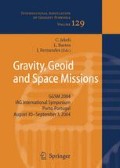Abstract
Generally, the gravity surveys are developed along roads or other communication ways. This leads to an irregular space distribution and lacking data in large areas, like that containing high mountains, wetlands, lakes and forests. The usual methods for geoid computation from gravity data need a regular grid of gravity anomalies. Numerous methods have been developed for gravity anomalies interpolation at regular distribution. This paper reports on implementation of an interpolation method by using techniques for learning and training of Artificial Neural Networks (ANN) in predicting both free-air and Bouguer gravity anomalies from irregular and sparse data. The method was applied for a region in the Ecuador (5°S - 1°N and 75°W – 81°W) that has strong variations in crustal density and morphology. The free-air gravity anomalies prediction results were compared with the method of Kriging interpolation. The ANN method presented better results in predicting gravity anomalies in the considered region.
Access this chapter
Tax calculation will be finalised at checkout
Purchases are for personal use only
Preview
Unable to display preview. Download preview PDF.
8 References
Cressie, N (1993). Statistics for Spatial Data. ISU, New York.
Li, Y., and Bridgwater, J (2000). Prediction of Extrusion Pressure Using Artificial Neural Network. Powder Technology 108: 65–73.
Haykin, S (1999). Neural Networks: A Comprehensive Foundation. 2. ed. New Jersey: Prentice Hall.
Haykin, S (2001). Redes Neurais: Princípios e Prática. 2. ed. Porto Alegre: Bookman.
Heiskanen, W., and Moritz, H (1967). Physical Geodesy. H. Freeman and Company.
Forsberg, R (1994). Terrain Effects in Geoid Computations. In: Lectures Notes of the International School for the Determination and Use of the Geoid. International Geoid Service, Milan.
Moritz, H (1980). Advanxed Physical Geodesy. H. Wichmann Verlag, Karlsruhe.
Muñoz, A (1996). Aplicación de Técnicas de Redes Neuronales Artificiales al Diagnóstico de Procesos Industriales. Ph.D. Thesis, Dept. de Electrotécnia y Sistemas, Universidad Pontificia Comillas de Madrid.
Loeseh, C., and Sari, S (1996). Redes Neurais Artificias. Fundamentos e Modelos. Blumenau, Brazil.
Smith, W., and Wessel, P (1990). Gridding with Continuous Curvature Splines in Tension. Geophysics 55(3):293–305.
Tierra, A., and De Freitas, S (2002). Predicting Free-Air Gravity Anomaly Using Artificial Neural Network. International Association of Geodesy Symposia: Vertical Reference Systems. Springe 124: 215–218.
Tierra, A (2003). Metodologia para a Geração da Malha de Anomalias Gravimétricas para Obtenção do Geoide Gravimétrico Local a partir de Dados Esparsos. Ph.D. Thesis Department of Geomatics, Federal University of Parana.
Torge, W (1989). Gravimetry. New York: de Gruyter, New York.
Watson, D (1992). Contouring: A Guide to the Analysis and Display of Spatial Data. Pergamon.
Author information
Authors and Affiliations
Editor information
Editors and Affiliations
Rights and permissions
Copyright information
© 2005 Springer-Verlag Berlin Heidelberg
About this paper
Cite this paper
Tierra, A., de Freitas, S. (2005). Artificial Neural Network: A Powerful Tool for Predicting Gravity Anomaly from Sparse Data. In: Jekeli, C., Bastos, L., Fernandes, J. (eds) Gravity, Geoid and Space Missions. International Association of Geodesy Symposia, vol 129. Springer, Berlin, Heidelberg. https://doi.org/10.1007/3-540-26932-0_36
Download citation
DOI: https://doi.org/10.1007/3-540-26932-0_36
Publisher Name: Springer, Berlin, Heidelberg
Print ISBN: 978-3-540-26930-4
Online ISBN: 978-3-540-26932-8
eBook Packages: Earth and Environmental ScienceEarth and Environmental Science (R0)

